
From the Jewish Virtual Library,"Sephardim," by Rebecca Weiner -- The descendants of Jews who left Spain or Portugal after the 1492 expulsion are referred to as Sephardim. The word “Sephardim” comes from the Hebrew word for Spain, Sepharad, that is stated in the Bible.
It is believed that Jews have lived in Spain since the era of King Solomon (c.965-930 B.C.E.). Little information can be found on these Jews until the beginning of the first century. We do know that in 305 C.E., the Council of Toledo passed an edict forbidding Jews from blessing the crops of non-Jews and prohibiting Jews and non-Jews from eating together.
In 409 C.E., the Visigoths conquered Spain. The Visigoths were Arian Christians, followers of Arius who reasoned that Jesus could not logically co-exist with God and must therefore be subservient to him.
In 587 C.E., King Reccared, the Visigoth king in Spain, converted to Roman Catholicism and made it the state religion. Subsequently, the Church was to exert powerful influence on all aspects of social life. Almost immediately, in 589 C.E., a canon was passed forbidding the marriage between Christians and Jews; and in 612 C.E., the Council of Gundemar of Toledo ordered that all Jews submit to baptism within the year.

In 638 C.E., the Arian Visigoths declared that “only Catholics could live in Spain.”
The Golden Age
The situation improved in 711 when Spain fell under the rule of the Muslim Moors. Both Muslims and Jews built a civilization, based in Cordoba, known as Al-Andalus, which was more advanced than any civilization in Europe at that time. Jews were able to coexist peacefully with their neighbors; however, they were still treated as dhimmis, "People of the Book" (Jews and Christians) who are protected under Islamic law. Jews did not have complete autonomy and had to pay a special tax, the jizha , but were able to freely practice their religion.
The era of Muslim rule in Spain (8th-11th century) was considered the "Golden Age" for Spanish Jewry. Jewish intellectual and spiritual life flourished and many Jews served in Spanish courts. Jewish economic expansion was unparalleled. In Toledo, Jews were involved in translating Arabic texts to the romance languages, as well as translating Greek and Hebrew texts into Arabic. Jews also contributed to botany, geography, medicine, mathematics, poetry and philosophy.
A number of well-known Jewish physicians practiced during this period, including Hasdai Ibn Shaprut (915-970), who was the doctor for the Caliph (leader of Spain). Many famous Jewish figures lived during the Golden Age and contributed to making this a flourishing period for Jewish thought. These included Samuel Ha-Nagid, Moses ibn Ezra, Solomon ibn Gabirol Judah Halevi and Moses Maimonides.
Jews lived separately in aljamas (Jewish quarters). They were given administrative control over their communities and managed their own communal affairs. Jews had their own court system, known as the Bet Din. Rabbis served as judges and rendered both religious and civil legal opinions.

Islamic culture also influenced the Jews. Muslim and Jewish customs and practices became intertwined. For example, Arabic was used for prayers rather than Hebrew or Spanish. Before entering the synagogue, Jews washed their hands and feet, which is a practice done before entering a mosque. Arab melodies were used for Jewish songs. Jews wore the clothing style of their Moorish neighbors, although they were not allowed to wear silk or furs.
Jews lived peacefully in Al-Andulus for 400 years. The Golden Age for Jewry in Muslim Spain declined after the Almovarids gained power in 1055 and continued to deteriorate after the Almohads came to power in 1147. Jews continued to work as moneylenders, jewelers, cobblers, tailors and tanners, however, they had to wear distinguishing clothing, such as a yellow turban.
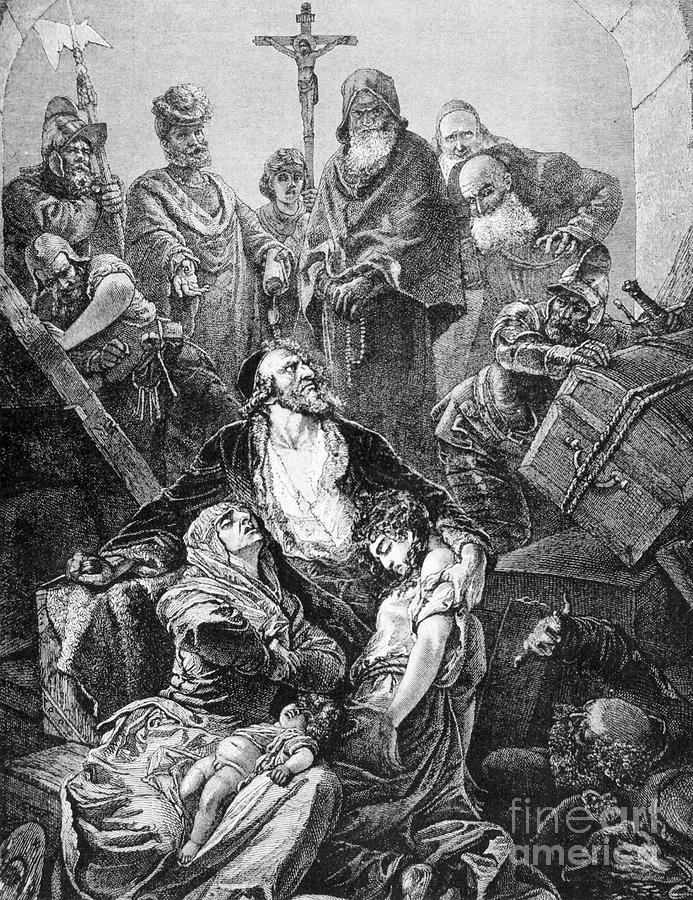
Christian Rule, the Inquisition and the Expulsion of 1492
The Christians conquered Toledo in 1098 and the Jews in Christian Spain prospered, while those in Muslim Spain suffered under the Almohad dynasty. Both Jews and Muslims were involved in the cultural, economic, intellectual, financial and political life of Christian Spain. By the mid-13th century, the Christians controlled most of Spain and increasingly forced Jews to convert to Christianity. Those who converted became known as Marranos or New Christians. Marranos are also known as crypto-Jews because they taught their children and practiced Judaism in secret. During this period, Jews were forced to participate in "religious" disputes with Christians counterparts.
Anti-Jewish riots broke out in 1391 in several Spanish cities and the situation worsened for the Jewish community. New Christians were tortured or killed in the Spanish Inquisition during the 15th century. Father Tomas de Torquemada felt that if the Jews remained in Spain, then they would influence the new converts to Christianity. After the capture of Granada from Muslim forces, Father Torquemada convinced King Ferdinand and Queen Isabella that the Jewish community was expendable. In 1492, Isabella and Ferdinand commanded that all Jews who refused to convert to Christianity be expelled from Spain. The Jews were given four months to leave Spain and were forced to sell their houses and businesses at low prices. It is estimated that 100,000 Jews left Spain at this time. The expulsion from Spain is commemorated every year by all Jews on the holiday of Tisha B’Av.
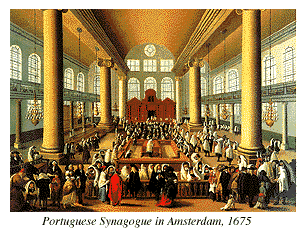
Many Spanish Jews settled in Portugal, which allowed the practice of Judaism. In 1497, however, Portugal also expelled its Jews. King Manuel of Portugal agreed to marry the daughter of Spain’s monarchs. One of the conditions for the marriage was the expulsion of Portugal’s Jewish community. In actuality only eight Jews were exiled from Portugal and the rest converted, under duress, to Christianity.
In the first Sephardi Diaspora, a large number of Jews settled in North Africa and in the Ottoman Empire, especially, Turkey and Greece. Spanish exiles brought with them a unique culture, language (Ladino) and traditions. Many of these immigrants continued to speak Ladino until the 20th century.
A Marrano Diaspora took place a century later. Some Marranos had settled in Portugal and eventually moved to Holland, where they were allowed to outwardly practice Judaism. Many settled in Western Europe and moved to the Americas. Marranos who settled in Latin America continued practicing crypto-Judaism for many years because Spain began an inquisition in its New World colonies. Fear of persecution led Crypto-Jews to settle in remote villages. Today, descendants of crypto-Jews can be found in Colorado and New Mexico.
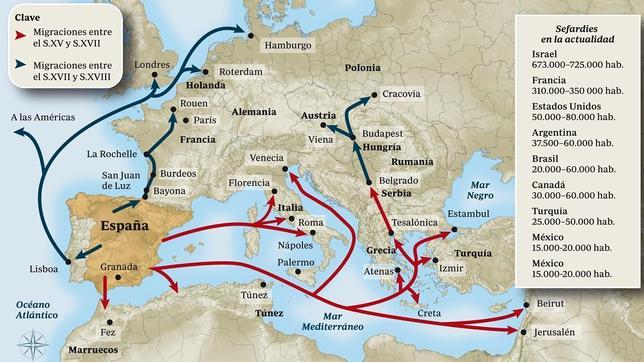
Exiled Sephardic Communities
Europe
Large Sephardic communities were founded in Venice, Leghorn, London, Bordeaux, Bayonne and Hamburg. These immigrants spoke Portugese and Spanish and many adapted mainstream Western European culture. Successful business enterprises were started by the Sephardim and their trade networks became famous worldwide.
Throughout the medieval period in Europe, the Sephardic Jews were treated as elites among Jews. Many times they had a secular education and often had great wealth. In the 18th century, the Sephardic Jews who lived in Amsterdam and in London, tended to discriminate against non-Sephardic Jews who wanted to pray at their synagogues by forcing them to sit separately from the rest of the congregation.

North Africa and the Arab World
For hundreds of years, Sephardic Jews lived, as dhimmis, in relative peace with Muslim neighbors and rulers in North Africa and in the Ottoman Empire. They were considered second-class citizens, but were free to practice their own religion and participate in commerce. Similar to Spain and Portugal during the Golden Era, the Sephardic upper class in the Ottoman empire were employed as translators.
The Sephardic communities in the Arab world were more receptive to modernity than their Ashkenazi counterparts in Europe. The Zionist movement became popular among Sephardic Jews in North Africa. Many Sephardic rabbis in the Ottoman Empire supported Zionism and the Zionist movement spread to many Muslim countries in North Africa, such as in Egypt and Tunisia.

World War II - Present
In World War II, Sephardim in Europe suffered the same fate as other Jews, and most perished during the Holocaust. In a few places, such as Holland, they received some preferential treatment, meaning they were among the last to be liquidated.
After the establishment of the State of Israel, conditions for Jews in many Islamic countries grew increasingly uncomfortable and, in some cases, their lives were threatened. In the 1950's and 1960's, tens of thousands of Sephardic Jews fled from North Africa and other countries in the Middle East to settle in Israel, usually being forced by the Muslim authorities to leave behind most of their worldly possessions. Once they came to Israel, most of the Sephardic immigrants were put in transit camps and became dependent on welfare. The conditions in these camps were very bad and it was difficult for the newcomers to work their way out of the lower rung of Israeli society because they had less education than the established Ashkenazic community. Consequently, many worked in blue-collar professions.
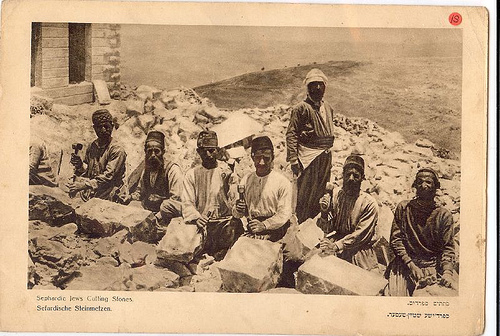
Today, tensions remain between Ashkenazim and Sephardim in Israel because of the poor treatment the latter received and the long, difficult road Sephardic Jews have had to travel to approach parity in society. Though they have not yet achieved equality, Sephardic Jews increasingly occupy positions of prestige and influence. Moroccan-born David Levy, for example, has served as foreign minister and, in July 2000, Iranian-born Moshe Katsav was elected president.
Besides Israel, other large Sephardic communities developed in Central and South America, Rhodesia and the Belgian Congo. Meanwhile, the existing communities in New York, Paris and London grew. One of the most famous Sephardic synagogues is Congregation Shearith Israel, the first Jewish congregation in North America, and the only Jewish congregation in New York from its founding in 1654 until 1825.
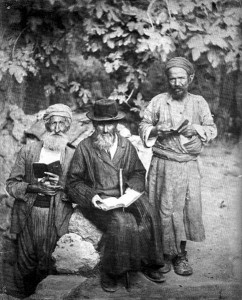
The Sephardi Jews preserved their special language, which was a combination of Hebrew and Spanish, known as Ladino. Ladino is still spoken by some Sephardic communities, such as those in Greece, Turkey, Bulgaria, Rumania, France and Latin America. Today the largest Ladino-speaking community can be found in Israel. One can also read Ladino in Sephardic literature.
When Jews left Spain and Portugal they continued to speak Ladino, in the same grammar and vocabulary of 14th and 15th century Spanish. The Sephardic exile communities of Amsterdam, London and Italy were still in contact with Spain and hence they continued to speak Castillian Spanish.

Exile communities in the Ottoman Empire, however, retained the 14th and 15th century Spanish and borrowed words from Hebrew, Arabic Greek, Turkish and French and diverged considerably from Castillian Spanish. There are many different Ladino dialects. An Oriental Ladino was used in Turkey and Rhodes, while a Western Ladino was spoken in Greece, Macedonia, Bosnia, Serbia and Rumania.
Ladino is written using Hebrew letters and often uses the Rashi script. In fact, Rashi script was originally a Ladino script; however, after Rashi’s death, this script was used to differentiate his commentary from others ones. More recently, in the 20th century, Ladino has been written using the Latin alphabet.

Photograph of Torah scrolls, the inspired word of God as told to Moses, in the ark at the Portuguese Sephardic Synagogue (Portugees-Israëlietische Synagoge) in Waterlooplein district of Amsterdam, Holland (Netherlands). Sefer Torah, is the most important document in the Jewish religion and is written in Hebrew by scribes on parchment. It is also known as the Five Books of Moses. , or Pentateuch. These Torahs are covered with richly embroidered Torah covers called Mapah and mounted with silver crowns or Rimonim. The Portuguese Sephardic Synagogue was built in 1671. Photograph by Nathan Benn taken July 26, 1979. (source: Jewish Diaspora Images)

Religious Practice
Sephardic and Ashkenazi Jews share the same tenets of Judaism, follow the Babylonian Talmud and the Shulkhan Arukh. Differences arise in customs and in liturgy. For example, on Passover, Sephardic Jews eat kitnyot, rice and corn products. Also, at many Sephardic sedars, the father will reenact the experience of gaining freedom by circling the sedar table and holding a symbolic bag over his shoulder.
Other differences exist in the way Sephardic Jews wind their tefillin straps outwards, whereas Ashkenazi Jews wind the tefillin inwards. Sephardic grooms are honored with an aliyah to the Torah on the Shabbat after their wedding, whereas Ashkenazi grooms are called up to the Torah the Shabbat before the wedding.

Sephardic Torah scrolls are usually stored in a large wooden cylinder, which stands erect when opened. The parchment is in an upright position when read, whereas, Ashkenazi scrolls just have an embroidered cover and the scrolls are read while lying flat on a table.
Sephardic liturgy uses the same basic prayers, but add different psalms and poems. The prayer, Ein Keloyheinu, is recited at the Saturday morning services for both Sephardic and Ashkenazic Jews, however, it is also read daily by Sephardic Jews. Sephardim also use a different cantillation for reading the Torah and different melodies for prayers. All Sephardic synagogues are traditional, women are seated separately, typically in a balcony. (source: Jewish Virtual Library)
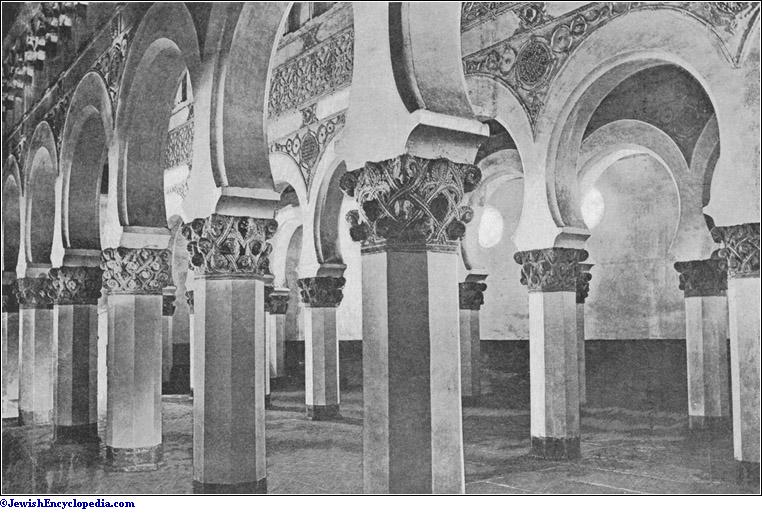
Arabs expelled a million plus adult Jews and their children from all their countries and confiscated their assets.
ReplyDeleteThe Jewish forced exodus from Arab lands refers to the 20th century expulsion or mass departure of Jews, primarily of Sephardi and Mizrahi background, from Arab and Islamic countries. The migration started in the late 19th century, but accelerated after the 1948 Arab-Israeli War. According to official Arab statistics, over 989,000 Jews were forced out of their homes in Arab countries from 1948 until the early 1970’s. Some 650,000 resettled in Israel, The Arab governments confiscated their assets, businesses, home and Real estate estimated at 120,000 square kilometers – 46,000 sq, miles (5-6 times the size of the State of Israel). Valued today in the trillions of dollars.
Let the 21 Arab countries resettle the Arab Palestinians in the land they confiscated from the Jews which is 5 times the size of Israel. Provide them with funds they confiscated from the million Jewish people they expelled and let them build an economy, This will benefit both the Arab-Palestinians and the hosting countries, The other alternative is relocate the Arab-Palestinians to Jordan, (originally land allocated for the Jewish people) which is already 80% Arab-Palestinians, and give them funds to relocate and build an economy. This will solve the Arab-Palestinians refugee problem once and for all. It will also reduce hostility and strife in the region.
They'd need tons of funds, and no imperialist bullshit from Israel/USA/anyone else. Israel should finance all of the building and not rape them with a central, private bank. They've been through enough. American soldiers should have to build everything instead of destroying any country that has any stability. But you're right, that's the only way to fix the problem. Certain bankers should have to help, but I doubt that they will unless they're setting them up for genocide in a different location.
DeleteSo Jews lived in a "Golden Age"? I'd call it the "Yellow Age of Oppression"-where they had to wear poorer clothing (and yellow to mark them as Jews), where they had to pay a "tax" just because they were Jews, where they had to live in only certain sections of the city, where they had to use Arab customs in their religious services (music, washing, etc.),
ReplyDeleteetc. In other words, they served their Masters the Arabs!
This was NO "Golden Age" for Jews!
Hola'
ReplyDeleteFace it - No Arab-Palestinian state west of the Jordan River
ReplyDeleteIf you read the 1917 Balfour Declaration (Which emulated Napoleons 1799 letter to the Jewish community in Palestine promising that The National Home for The Jewish people will be reestablished in Palestine, as the Jews are the rightful owners). Nowhere does it state an Arab entity west of The Jordan River.
The San Remo Conference of April 1920 which incorporated The Balfour Declaration into International Law with no boundary restrictions it does not state an Arab entity west of The Jordan River, confirmed by Article 95 in the 1920 Treaty of Sevres which was signed by all the Allied Powers and the Treaty of Lausanne.
The Mandate for Palestine terms does not state an Arab entity west of the Jordan River. It specifically states a Jewish National Home in Palestine without limiting or restricting the Jewish territory in Palestine. It also states that the British should work with the Jewish Agency as the official representative of the Jews in Palestine to implement the National Home of the Jewish people in Palestine. I stress again; nowhere does it state that an Arab entity should be implemented west of the Jordan River.
As a matter of historical record, The British reallocated illegally over 77% of Jewish Palestine to the Arab-Palestinians in 1922 with specific borders and Jordan took over additional territory like the Gulf of Aqaba which was not part of the allocation to Jordan. The British also illegally and in violation of treaty, traded the Jewish Golan Heights to the French for the right to Iraq and its oil..
The United Nations resolutions are non binding with no legal standing it does not create an Arab Palestinian state and it has no authority to change the April 1920 San Remo treaty or modify the terms of the Mandate for Palestine which has the force of international law in perpetuity.
No where in any of the above stated agreements does it provides for an Arab entity west of the Jordan River. The U.N. and General Assembly resolutions are non-binding with no legal standing, same applies to the ICJ. The Oslo Accords are null and void as state by Mahmmoud Abbas at the U.N.
Israel must disband the Arab-PA and take back full control and sovereignty of all the territory west of the Jordan River – All of Judea and Samaria without delay. Time for talk is over. Now is the time for action to restore our Jewish sovereignty in all the Land of Israel and stop terror and violence.
It is time to relocate the Arabs in Israel to Jordan and to the homes and the over 120,000 sq. km. of Jewish land the Arab countries confiscated from the over a million Jewish families that they terrorized and expelled and those expelled Jews were resettled in Israel. They can use the trillions of dollars in reparations for the Jewish assets to finance the relocation of the Arabs and help set-up an economy and industry instead of living on the world charity. The Arab countries were allocated over 13 million sq. km. (6 million sq. miles) with a wealth of oil reserves.
YJ Draiman
P.S. Possession is nine tenths of the law – Israel has it.
Political Rights in Palestine aka The Land of Israel were granted only and exclusively to the Jews in all of Palestine and the right to settle in all of Palestine with no exclusions.
The Jewish people’s war of survival was not won when Hitler lost. It continues to this day, against enemies with more effective tools of mass murder at their disposal.
Plus we are easy to find now.